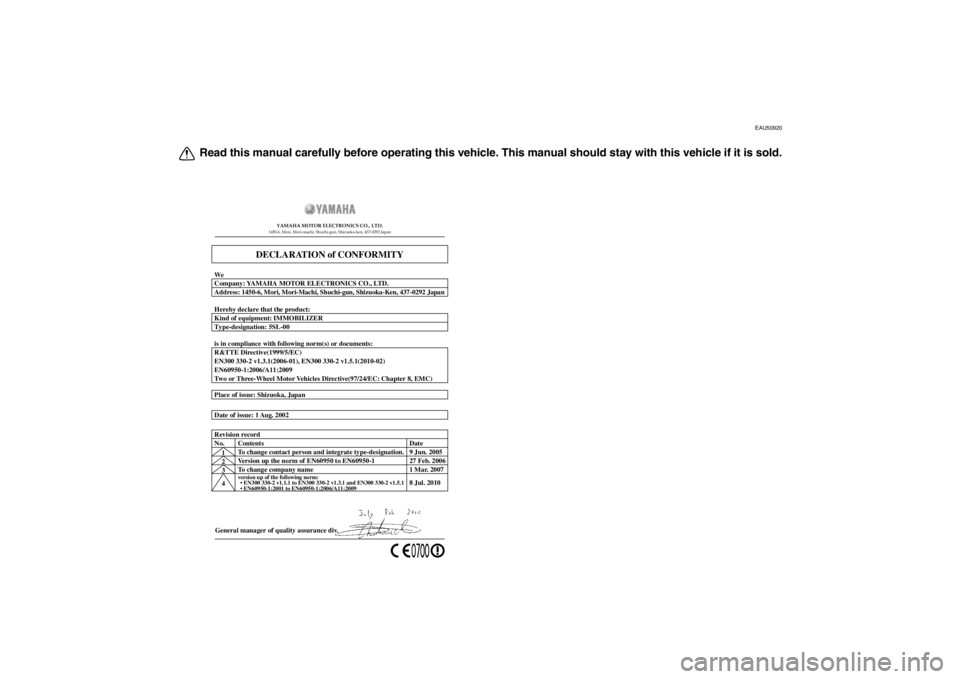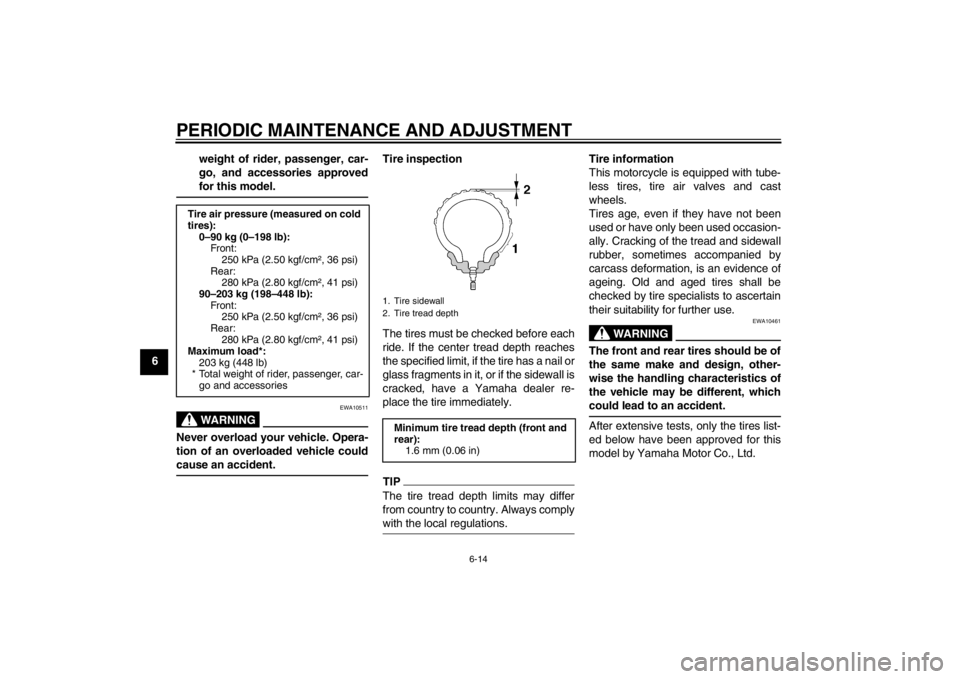wheel YAMAHA XV1900A 2013 Owners Manual
[x] Cancel search | Manufacturer: YAMAHA, Model Year: 2013, Model line: XV1900A, Model: YAMAHA XV1900A 2013Pages: 88, PDF Size: 1.75 MB
Page 2 of 88

EAU50920
Read this manual carefully before operating this vehicle. This manual should stay with this vehicle if it is sold.
General manager of quality assurance div.
Date of issue: 1 Aug. 2002 Place of issue: Shizuoka, Japan
DECLARATION of CONFORMITY
YAMAHA MOTOR ELECTRONICS CO., LTD.1450-6, Mori, Mori-machi, Shuchi-gun, Shizuoka-ken, 437-0292 Japan
Company: YAMAHA MOTOR ELECTRONICS CO., LTD. We
Address: 1450-6, Mori, Mori-Machi, Shuchi-gun, Shizuoka-Ken, 437-0292 Japan
Kind of equipment: IMMOBILIZER Hereby declare that the product:
Type-designation: 5SL-00
is in compliance with following norm(s) or documents:
R&TTE Directive(1999/5/EC)
EN300 330-2 v1.3.1(2006-01), EN300 330-2 v1.5.1(2010-02)
EN60950-1:2006/A11:2009
Two or Three-Wheel Motor Vehicles Directive(97/24/EC: Chapter 8, EMC)
1
2
3
4 Version up the norm of EN60950 to EN60950-1
To change company name
version up of the following norm:
• EN300 330-2 v1.1.1 to EN300 330-2 v1.3.1 and EN300 330-2 v1.5.1
27 Feb. 2006
1 Mar. 2007
8 Jul. 2010
Revision record
No. Contents
To change contact person and integrate type-designation. Date
9 Jun. 2005
U1CRE2E0.book Page 1 Monday, September 17, 2012 9:05 AM
Page 6 of 88

TABLE OF CONTENTSSAFETY INFORMATION ..................1-1
DESCRIPTION ..................................2-1
Left view ..........................................2-1
Right view ........................................2-2
Controls and instruments.................2-3
INSTRUMENT AND CONTROL
FUNCTIONS .......................................3-1
Immobilizer system .........................3-1
Main switch/steering lock ................3-2
Indicator lights and warning lights ..............................3-4
Multi-function meter unit .................3-5
Handlebar switches ......................3-10
Clutch lever ...................................3-11
Shift pedal .....................................3-12
Brake lever ...................................3-12
Brake pedal ..................................3-12
Fuel tank cap ................................3-13
Fuel ...............................................3-13
Fuel tank breather/ overflow hose ............................3-15
Catalytic converter ........................3-15
Rider seat .....................................3-16
Helmet holder ...............................3-16
Adjusting the shock absorber assembly ...................................3-17
EXUP system ...............................3-19
Sidestand ......................................3-19
Ignition circuit cut-off system ........3-20 Auxiliary DC connector ................. 3-22
FOR YOUR SAFETY –
PRE-OPERATION CHECKS ............. 4-1
OPERATION AND IMPORTANT
RIDING POINTS ................................. 5-1
Starting the engine ......................... 5-1
Shifting ........................................... 5-2
Tips for reducing fuel consumption ............................... 5-3
Engine break-in .............................. 5-3
Parking ........................................... 5-4
PERIODIC MAINTENANCE AND
ADJUSTMENT ................................... 6-1
Owner’s tool kit ............................... 6-2
Periodic maintenance chart for the
emission control system ............. 6-3
General maintenance and
lubrication chart .......................... 6-4
Checking the spark plugs ............... 6-8
Engine oil and oil filter cartridge ..... 6-9
Transfer case oil ........................... 6-12
Air filter element ........................... 6-12
Checking the throttle grip free play ............................. 6-13
Valve clearance ............................ 6-13
Tires ............................................. 6-13
Cast wheels .................................. 6-15
Clutch lever .................................. 6-15 Checking the brake
lever free play ........................... 6-16
Brake light switches ..................... 6-16
Checking the front and rear brake pads ................................ 6-17
Checking the brake and clutch fluid levels ...................... 6-17
Changing the brake and
clutch fluids ............................... 6-19
Drive belt slack ............................ 6-19
Checking and lubricating the cables ................................. 6-20
Checking and lubricating the throttle grip and cable ............... 6-20
Checking and lubricating the brake and shift pedals .............. 6-21
Checking and lubricating the
brake and clutch levers ............ 6-21
Checking and lubricating the sidestand ............................ 6-22
Lubricating the rear suspension ... 6-22
Checking the front fork ................. 6-23
Checking the steering .................. 6-23
Checking the wheel bearings ....... 6-24
Battery ......................................... 6-24
Replacing the fuses ..................... 6-25
Replacing a headlight bulb .......... 6-26
Tail/brake light ............................. 6-29
Replacing a turn signal light bulb ................................... 6-29
License plate light ........................ 6-29U1CRE2E0.book Page 1 Monday, September 17, 2012 9:05 AM
Page 9 of 88

SAFETY INFORMATION
1-2
1
●
Many accidents involve inexperi-
enced operators. In fact, many op-
erators who have been involved in
accidents do not even have a cur-
rent motorcycle license. Make sure that you are qualified and that you only lend your mo-
torcycle to other qualified opera-
tors.
Know your skills and limits. Staying within your limits may
help you to avoid an accident.
We recommend that you prac- tice riding your motorcycle
where there is no traffic until you
have become thoroughly famil-
iar with the motorcycle and all of
its controls.
●
Many accidents have been caused
by error of the motorcycle opera-
tor. A typical error made by the op-
erator is veering wide on a turn
due to excessive speed or under-
cornering (insufficient lean angle
for the speed). Always obey the speed limit and never travel faster than warrant-
ed by road and traffic conditions. Always signal before turning or
changing lanes. Make sure that
other motorists can see you.
●
The posture of the operator and
passenger is important for proper
control. The operator should keep both hands on the handlebar and
both feet on the operator foot-
rests during operation to main-
tain control of the motorcycle.
The passenger should always hold onto the operator, the seat
strap or grab bar, if equipped,
with both hands and keep both
feet on the passenger footrests.
Never carry a passenger unless
he or she can firmly place both
feet on the passenger footrests.
●
Never ride under the influence of
alcohol or other drugs.
●
This motorcycle is designed for on-
road use only. It is not suitable for
off-road use. Protective Apparel
The majority of fatalities from motorcy-
cle accidents are the result of head in-
juries. The use of a safety helmet is the
single most critical factor in the preven-
tion or reduction of head injuries.
●
Always wear an approved helmet.
●
Wear a face shield or goggles.
Wind in your unprotected eyes
could contribute to an impairment
of vision that could delay seeing a
hazard.
●
The use of a jacket, heavy boots,
trousers, gloves, etc., is effective in
preventing or reducing abrasions
or lacerations.
●
Never wear loose-fitting clothes,
otherwise they could catch on the
control levers, footrests, or wheels
and cause injury or an accident.
●
Always wear protective clothing
that covers your legs, ankles, and
feet. The engine or exhaust sys-
tem become very hot during or af-
ter operation and can cause burns.
●
A passenger should also observe
the above precautions.
U1CRE2E0.book Page 2 Monday, September 17, 2012 9:05 AM
Page 12 of 88

SAFETY INFORMATION
1-5
1tor and may limit control ability,
therefore, such accessories are
not recommended.
●
Use caution when adding electri-
cal accessories. If electrical acces-
sories exceed the capacity of the
motorcycle’s electrical system, an
electric failure could result, which
could cause a dangerous loss of
lights or engine power.
Aftermarket Tires and Rims
The tires and rims that came with your
motorcycle were designed to match the
performance capabilities and to provide
the best combination of handling, brak-
ing, and comfort. Other tires, rims, siz-
es, and combinations may not be
appropriate. Refer to page 6-13 for tire
specifications and more information on
replacing your tires.
Transporting the Motorcycle
Be sure to observe following instruc-
tions before transporting the motorcy-
cle in another vehicle.
●
Remove all loose items from the
motorcycle.
●
Check that the fuel cock (if
equipped) is in the “OFF” position
and that there are no fuel leaks.
●
Point the front wheel straight
ahead on the trailer or in the truck
bed, and choke it in a rail to pre-
vent movement.
●
Shift the transmission in gear (for
models with a manual transmis-
sion).
●
Secure the motorcycle with tie-
downs or suitable straps that are
attached to solid parts of the mo-
torcycle, such as the frame or up-
per front fork triple clamp (and not,
for example, to rubber-mounted
handlebars or turn signals, or parts
that could break). Choose the lo-
cation for the straps carefully so
the straps will not rub against
painted surfaces during transport.
●
The suspension should be com-
pressed somewhat by the tie-
downs, if possible, so that the mo-
torcycle will not bounce excessive-
ly during transport.
U1CRE2E0.book Page 5 Monday, September 17, 2012 9:05 AM
Page 39 of 88

FOR YOUR SAFETY – PRE-OPERATION CHECKS
4-2
4
Rear brake Check operation.
If soft or spongy, have Yamaha dealer bleed hydraulic system.
Check brake pads for wear.
Replace if necessary.
Check fluid level in reservoir.
If necessary, add specified brake fluid to specified level.
Check hydraulic system for leakage. 6-17, 6-17
Clutch Check operation.
If soft or spongy, have Yamaha dealer bleed hydraulic system.
Check fluid level in reservoir.
If necessary, add specified brake fluid to specified level.
Check hydraulic system for leakage. 6-15, 6-17
Throttle grip Make sure that operation is smooth.
Check throttle grip free play.
If necessary, have Yamaha dealer adjust throttle grip free play and lubricate cable
and grip housing. 6-13, 6-20
Control cables Make sure that operation is smooth.
Lubricate if necessary. 6-20
Wheels and tires Check for damage.
Check tire condition and tread depth.
Check air pressure.
Correct if necessary.
6-13, 6-15
Brake and shift pedals Make sure that operation is smooth.
Lubricate pedal pivoting points if necessary.
6-21
Brake and clutch levers Make sure that operation is smooth.
Lubricate lever pivoting points if necessary. 6-21
Sidestand Make sure that operation is smooth.
Lubricate pivot if necessary.
6-22
Chassis fasteners Make sure that all nuts, bolts and screws are properly tightened.
Tighten if necessary.
—
ITEM CHECKS PAGE
U1CRE2E0.book Page 2 Monday, September 17, 2012 9:05 AM
Page 48 of 88

PERIODIC MAINTENANCE AND ADJUSTMENT
6-4
6
EAU1770F
General maintenance and lubrication chart NO. ITEM CHECK OR MAINTENANCE JOB ODOMETER READING
ANNUAL
CHECK
1000 km
(600 mi) 10000 km
(6000 mi) 20000 km
(12000 mi) 30000 km
(18000 mi) 40000 km
(24000 mi)
1 *Air filter element Replace. √
2 *Clutch Check operation, fluid level and
vehicle for fluid leakage. √√√√√
3 *Front brake Check operation, fluid level and
vehicle for fluid leakage. √√√√√√
Replace brake pads. Whenever worn to the limit
4 *Rear brake Check operation, fluid level and
vehicle for fluid leakage. √√√√√√
Replace brake pads. Whenever worn to the limit
5 *Brake hoses Check for cracks or damage.
Check for correct routing and
clamping. √√√√√
Replace. Every 4 years
6 *Brake fluid Replace. Every 2 years
7 *Wheels Check runout and for damage. √√√√
8 *Tires Check tread depth and for dam-
age.
Replace if necessary.
Check air pressure.
Correct if necessary. √√√√√
9 *Wheel bearings Check bearing for looseness or
damage. √√√√
10 *Swingarm Check operation and for exces-
sive play. √√√√
U1CRE2E0.book Page 4 Monday, September 17, 2012 9:05 AM
Page 49 of 88

PERIODIC MAINTENANCE AND ADJUSTMENT
6-5
6
11*Drive belt Check belt condition.
Replace if damaged.
Check belt tension.
Make sure that the rear wheel is
properly aligned. Every 4000 km (2500 mi)
12 *Steering bearings Check bearing play and steering
for roughness. √√√√√
Lubricate with lithium-soap-based grease. Every 50000 km (30000 mi)
13 *Chassis fasteners Make sure that all nuts, bolts and
screws are properly tightened. √√√√√
14 Brake lever pivot
shaft
Lubricate with silicone grease.
√√√√√
15 Brake pedal pivot
shaft Lubricate with lithium-soap-based
grease. √√√√√
16 Clutch lever pivot
shaft Lubricate with silicone grease.
√√√√√
17 Shift pedal pivot
shaft Lubricate with lithium-soap-based
grease. √√√√√
18 Sidestand Check operation.
Lubricate with lithium-soap-based
grease. √√√√√
19 *Sidestand switch Check operation. √√√√√√
20 *Front fork Check operation and for oil leak-
age. √√√√
21 *Shock absorber as-
sembly Check operation and shock ab-
sorber for oil leakage. √√√√
NO. ITEM CHECK OR MAINTENANCE JOB
ODOMETER READING
ANNUAL
CHECK
1000 km
(600 mi) 10000 km
(6000 mi) 20000 km
(12000 mi) 30000 km
(18000 mi) 40000 km
(24000 mi)
U1CRE2E0.book Page 5 Monday, September 17, 2012 9:05 AM
Page 58 of 88

PERIODIC MAINTENANCE AND ADJUSTMENT
6-14
6weight of rider, passenger, car-
go, and accessories approved
for this model.
WARNING
EWA10511
Never overload your vehicle. Opera-
tion of an overloaded vehicle could
cause an accident.
Tire inspection
The tires must be checked before each
ride. If the center tread depth reaches
the specified limit, if the tire has a nail or
glass fragments in it, or if the sidewall is
cracked, have a Yamaha dealer re-
place the tire immediately.TIPThe tire tread depth limits may differ
from country to country. Always comply
with the local regulations.
Tire information
This motorcycle is equipped with tube-
less tires, tire air valves and cast
wheels.
Tires age, even if they have not been
used or have only been used occasion-
ally. Cracking of the tread and sidewall
rubber, sometimes accompanied by
carcass deformation, is an evidence of
ageing. Old and aged tires shall be
checked by tire specialists to ascertain
their suitability for further use.
WARNING
EWA10461
The front and rear tires should be of
the same make and design, other-
wise the handling characteristics of
the vehicle may be different, which
could lead to an accident.After extensive tests, only the tires list-
ed below have been approved for this
model by Yamaha Motor Co., Ltd.
Tire air pressure (measured on cold
tires):
0–90 kg (0–198 lb):Front:
250 kPa (2.50 kgf/cm², 36 psi)
Rear: 280 kPa (2.80 kgf/cm², 41 psi)
90–203 kg (198–448 lb): Front:250 kPa (2.50 kgf/cm², 36 psi)
Rear: 280 kPa (2.80 kgf/cm², 41 psi)
Maximum load*:
203 kg (448 lb)
* Total weight of rider, passenger, car- go and accessories
1. Tire sidewall
2. Tire tread depthMinimum tire tread depth (front and
rear): 1.6 mm (0.06 in)
U1CRE2E0.book Page 14 Monday, September 17, 2012 9:05 AM
Page 59 of 88

PERIODIC MAINTENANCE AND ADJUSTMENT
6-15
6
WARNING
EWA10471
●
Have a Yamaha dealer replace
excessively worn tires. Besides
being illegal, operating the vehi-
cle with excessively worn tires
decreases riding stability and
can lead to loss of control.
●
The replacement of all wheel
and brake-related parts, includ-
ing the tires, should be left to a
Yamaha dealer, who has the necessary professional knowl-
edge and experience to do so.
●
Ride at moderate speeds after
changing a tire since the tire
surface must first be “broken
in” for it to develop its optimal
characteristics.
EAU21962
Cast wheels To maximize the performance, durabil-
ity, and safe operation of your vehicle,
note the following points regarding the
specified wheels.●
The wheel rims should be checked
for cracks, bends, warpage or oth-
er damage before each ride. If any
damage is found, have a Yamaha
dealer replace the wheel. Do not
attempt even the smallest repair to
the wheel. A deformed or cracked
wheel must be replaced.
●
The wheel should be balanced
whenever either the tire or wheel
has been changed or replaced. An
unbalanced wheel can result in
poor performance, adverse han-
dling characteristics, and a short-
ened tire life.
EAU22073
Clutch lever Since this model is equipped with a hy-
draulic clutch, adjusting the clutch lever
free play is not needed. However, it is
necessary to check the clutch fluid level
and check the hydraulic system for
leakage before each ride. (See page
6-17.) If the clutch lever free play does
become excessive, and shifting be-
comes rough or clutch slippage occurs,
causing poor acceleration, there may
be air in the clutch system. If there is air
in the hydraulic system, have a
Yamaha dealer bleed the system be-
fore operating the motorcycle.
Front tire: Size:
130/70R18M/C 63H
Manufacturer/model:
DUNLOP/D251F L
Rear tire: Size:
190/60R17M/C 78H
Manufacturer/model: DUNLOP/D251
U1CRE2E0.book Page 15 Monday, September 17, 2012 9:05 AM
Page 67 of 88

PERIODIC MAINTENANCE AND ADJUSTMENT
6-23
6
EAU51950
Checking the front fork The condition and operation of the front
fork must be checked as follows at the
intervals specified in the periodic main-
tenance and lubrication chart.
To check the condition
Check the front fork for damage and ex-
cessive oil leakage.
To check the operation1. Place the vehicle on a level sur- face and hold it in an upright posi-
tion. WARNING! To avoid injury,
securely support the vehicle so
there is no danger of it falling
over.
[EWA10751]
2. While applying the front brake, push down hard on the handlebars
several times to check if the front
fork compresses and rebounds
smoothly.
NOTICE
ECA10590
If any damage is found or the front
fork does not operate smoothly,
have a Yamaha dealer check or re-
pair it.
EAU23283
Checking the steering Worn or loose steering bearings may
cause danger. Therefore, the operation
of the steering must be checked as fol-
lows at the intervals specified in the pe-
riodic maintenance and lubrication
chart.1. Place a stand under the engine to raise the front wheel off the
ground. (See page 6-30 for more
information.) WARNING! To
avoid injury, securely support
the vehicle so there is no danger
of it falling over.
[EWA10751]
2. Hold the lower ends of the front fork legs and try to move them for-
ward and backward. If any free
play can be felt, have a Yamaha
dealer check or repair the steering.
U1CRE2E0.book Page 23 Monday, September 17, 2012 9:05 AM